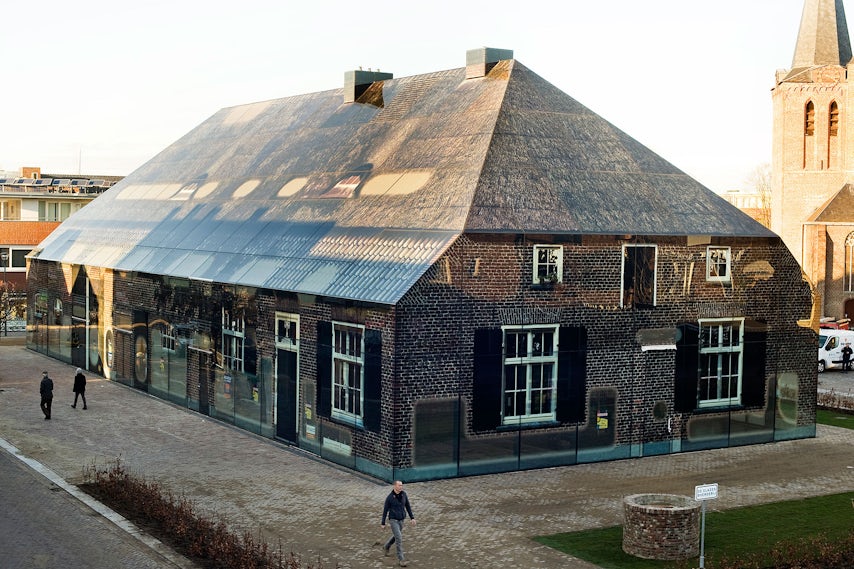French architects have an abundance of colorful characters throughout their country’s history to take inspiration from, from Charles Garnier and Gustave Eiffel to Philippe Starck and Jean Nouvel. Indeed, those practicing in Gallic lands are spoiled for choice when discussing the impact on contemporary architecture from Calais to Cannes, and Strasbourg-based studio Dominique Coulon and Associés appreciates the plethora of built muses surrounding them.
“French architectural heritage is of great wealth,” reflects Coulon. “Sources of inspiration can be in the work of Le Corbusier, but also in the density which one can feel while sauntering in a Cistercian abbey.”

Louis Pasteur High School in Strasbourg, France, 1996
As well as these icons of the built environment, Coulon had inspiration close at hand in the form of professor and architect Henri Ciriani, whom he graduated under in 1989. Ciriani’s modernist ideals clearly made a strong impression on the newly qualified architect, who was eager to start his own studio immediately upon completion of his degree: “I have a literary training to which I remain very attached. Following my studies of architecture, nothing was opposed to the creation of my own agency; this is why I opened my office shortly after obtaining my diploma. I couldn’t imagine working within another structure.”
This proactive attitude bore professional fruit almost instantly. In 1990, Coulon received a special prize in an international competition for the Japan Culture House in Paris and followed this up winning a travel residence with the Beyond the Walls program (la Villa Medicis Hors Les Murs), sparking travels to the United States, South America, and Europe. Back in his home city of Strasbourg, the architect was soon recognized for one of his first major works, the Louis Pasteur High School, for which he received the 1ère œuvre prize in 1996.

Josephine Baker’s group of schools, La Courneuve, France, 2010
Coulon’s penchant for education design continues to the present day, illustrated by Josephine Baker’s group of schools completed in 2010 in La Courneuve. The bold, bright forms of the classrooms and gymnasium channel the spirit of Le Corbusier and other masters of modernism, but are distinguishable from more sober examples of the genre on account of Coulon’s striking use of color.

Josephine Baker’s Group of Schools, La Courneuve, France, 2010
“In certain cases, the color puts pressure on space,” explains the architect. “What interests me is the power that it has to transform the perception of certain places. Color’s power of attraction controls the senses in an authoritative way, suggesting spaces that are almost destabilizing.”
The extraordinary burst of orange that floods the school’s courtyard and flows through the corridors is symptomatic of Coulon’s love of color as an architectural device, transforming buildings into abstract canvases of intense contrasts with pockets of shocking vibrancy.

Swimming Pool in Bagneux, France, 2014
This daring combination of gleaming white and immersive blocks of color has become a trademark of the firm’s work, with similar chromatic delights on show at the Swimming Pool in Bagneux. South of Paris, the public bath is a theatrical exemplar of the minimalist movement, where you may feel like you have inadvertently swum into a cutting-edge contemporary art gallery.

Refurbishment of the Gaujot State Administrative District, France, 2007
No matter what context or sector he is working within, Coulon serves up similar treats for the end users of each project: if the refurbishment of the Gaujot State Adminstrative District is a raspberry-ripple-flavored renovation, then the yellow interior of the Multicultural Centre in Isbergues is an architectural lemon sherbet. These spaces ooze optimism and go to show just how uplifting modernism can be despite its straight-faced reputation.

Multicultural Centre in Isbergues, France, 2013
Where the colors give way to snow-white planes, Coulon’s structures have a hint of Japanese style about them, a fact which is thrown into clarity when the architect lists firms and works that are currently exciting him the most:
“I very much like the work of Sou Fujimoto. I find that his approach is at the same time conceptual and poetic. I also like the buildings that re-interrogate the uses and the practice of space. The Rolex Center of the Sanaa Agency and Casa da Musica of Rem Koolhaas are, for me, buildings that mark a key stage in the history of architecture. I am also impatiently anticipating the delivery of Taichung Metropolitan Opera by Toyo Ito.”

Library in Anzin, France, 2010
As for Dominique Coulon and Associés itself, prospects look rosy. The firm has a number of projects in the works, and Coulon hopes to expand horizons further still. “In the years to come, we wish to continue a critical and interrogative approach”, says the architect, “in varied fields widening to include urban design or town planning.”
With a splash of color and a touch of Corbusian class, Coulon will keep branching out: it seems France has plenty to look forward to from the modernists of Strasbourg.









